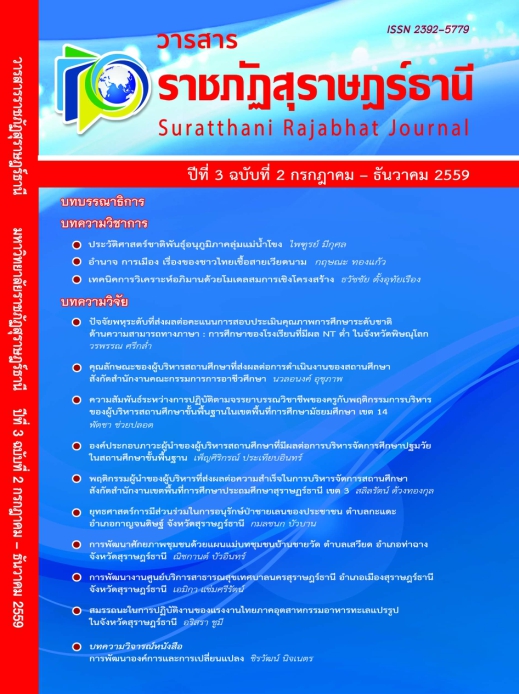เทคนิคการวิเคราะห์อภิมานด้วยโมเดลสมการเชิงโครงสร้าง
Main Article Content
บทคัดย่อ
บทความนี้รายงานผลการศึกษาการใช้สถิติการวิเคราะห์อภิมานด้วยโมเดลสมการเชิงโครงสร้าง ตามแนวคิดของ Cheung (2009b, 2010) โดยทำเป็นกรณีศึกษาการสังเคราะห์องค์ประกอบของภาวะผู้นำทางการศึกษาจากดุษฎีนิพนธ์ 4 เล่ม มีตัวแปรสังเกตได้ 17 ตัวแปร และตัวแปรแฝง 4 ตัวแปร จำนวนกลุ่มตัวอย่างรวม 2,370 คน โดยมีขั้นตอน 3 ขั้นตอน ดังนี้ ขั้นตอนที่ 1 การจัดเตรียมข้อมูล นำข้อมูลจากตารางสหสัมพันธ์มาป้อนเข้าระบบเพื่อเตรียม การวิเคราะห์ ขั้นตอนที่ 2 การวิเคราะห์ทดสอบระดับความเป็นเอกพันธ์และคำนวณหาเมทริกซ์สหสัมพันธ์ร่วม และขั้นตอนที่ 3 คือ การวิเคราะห์โมเดลด้วยวิธีการสมการเชิงโครงสร้างจากผลการศึกษากรณีตัวอย่างพบว่า โปรแกรมวิเคราะห์ผลค่าดัชนีความสอดคล้องอยู่ในระดับดี (RMSEA = 0.0500, CFI = 0.9735) และทำให้พบว่าเป็นการวิเคราะห์ที่น่าสนใจสำหรับนักวิจัยที่ต้องการวิเคราะห์อภิมานด้วยโมเดลสมการเชิงโครงสร้าง
Article Details
เอกสารอ้างอิง
Carson, P. P., Carson, K. D., & Roe, C. W. (1993). Social Power Bases: A Meta - Anaiytic Examination of Interrelationships and Outcomes1. Journal of Applied Social Psychology, 23(14), 1150 - 1169.
Cheung, M.W.L. & Chan, W. (2005). Meta-analytic structural equation modeling: a two-stage approach. Psychological Methods, 10(1), 40.
Cheung, M.W.L. (2009a). Meta – analysis: A Structural Equation Modeling Perspective. Paper presented at the Association for Psychological Science 21st Annual Convention, San Francisco, CA, USA.
Cheung, M.W.L. (2009b). Modeling multivariate effect sizes with structural equation models. Structural Equation Modeling, 17(3), 481 - 509.
Cheung, M.W.L. (2010). Fixed-effects meta-analyses as multiple-group structural equation models. Structural Equation Modeling, 17, 481 -509.
Colquitt, J. A., LePine, J. A., & Noe, R. A. (2000). Toward an integrative theory of training motivation: A meta-analytic path analysis of 20 years of research. Journal of Applied Psychology, 85, 678 –707.
Cudeck, R. (1989), "Analysis of Correlation Matrices Using Covariance Structure Models," Psychological Bulletin, 105(2), 317 - 327.
Furlow, C.F., & Beretvas, S.N. (2005). Meta-analytic methods of pooling correlation matrices for structural equation modeling under different patterns of missing data. Psychological Methods, 10, 227 - 254.
Generalized Least Square (n.d.).In Wikipedia. (Online) Retrieved from : http://en.wikipedia.org/wiki/Generalized_least_squares. [2015, March 24].
Glass, G. V., MacGaw, B., & Smith, M. L. (1984). Meta - analysis in social research. Beverly Hills, CA. : Sage.
Hafdahl, A.R. (2001). Multivariate meta-analysis for exploratory factor analytic research. Unpublished doctoral dissertation, University of North Carolina at Chapel Hill.
Hedges, L. & Olkin, I. (1985). Statistical models for meta-analysis. New York : Academic Press.
Hom, P.W., Caranikas-Walker, F., Prussia, G.E., & Griffeth, R.W. (1992). A meta-analytical structural equations analysis of a model of employee turnover. Journal of Applied Psychology, 77(6), 890.
Hunter, J. E. (1983). A causal analysis of cognitive ability, job knowledge, job performance, and supervisor ratings. In F. Landy, S. Zedeck, and J. Cleveland (Eds.), Performance measurement and theory. Hillsdale, NJ : Erlbaum. 257 – 266.
Hunter, J. E., Schmidt, F. L., & Jackson, G. B. (1982). Meta-analysis: Cumulating research findings across studies, 4.
Hunter, J.E., & Schmidt, F.L. (1990). Methods of meta–analysis: Correcting error and bias in research findings. Newbury Park, CA : Sage.
Hunter, J.E. & Schmidt, F.L. (2004). Methods of meta-analysis: Correcting error and bias in research findings. (2nded.). Thousand Oaks, CA : Sage.
Jöreskog, K.G. & Sörbom, D. (1996). LISREL 8 user's reference guide. Scientific Software International.
Mullen, B. (1989). Advance BASIC meta - analysis. Hillsdale, NJ : Erlbaum.
Premack, S. L. & Hunter, J. E. (1988). Individual unionization decisions. Psychological Bulletin, 103(2), 223.
Rosenthal, R. (1991). Essentials of behavioral research: Methods and data analysis. Mc Graw - Hill Humanities Social.
Schmidt, F. L. Hunter, J. E., & Outerbridge, A. N. (1986). Impact of job experience and ability on job knowledge, work sample performance, and supervisory ratings of job performance. Journal of applied psychology, 71(3), 432.
Silver, N.C. & Dunlap, W.P. (1987). Averaging correlation coefficients: should Fisher's z transformation be used? Journal of Applied Psychology, 72(1), 146.
Slavin, R. E. (1986). Best-evidence synthesis: An alternative to meta-analytic and traditional reviews. Educational researcher, 15(9), 5 - 11.
Tangutairuang, T. (2015). Meta-Analysis SEM in Leadership. (Online) Retrieved from : http://www.slideshare.net/twatchait/meta-analysisseminleadership. [2015, May 20].
Tett, R. P. & Meyer, J. P. (1993). Job satisfaction, organizational commitment, turnover intention, and turnover: Path analyses based on meta-analytic findings. Personnel Psychology, 46, 259 – 290.
Viswesvaran, C. & Ones, D.S. (1995). Theory testing: combining psychometric meta - analysis and structural equations modeling. Personnel Psychology, 48(4), 865 - 885.
Wilson, D.B. (2015). Meta - analysis macros for SAS, SPSS, and Stata. (Online) Retrieved from : http://mason.gmu.edu/~dwilsonb/ma.html. [2015, May 3].
Wiratchai, N. & Wongwanich, S. (1998). Educational Research Synthesis with Meta-Analysis and Content Analysis. The Office of Education Commission, Bangkok, Thailand. (in Thai)


